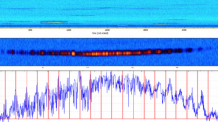Articles

This mock-up (courtesy of Dr Steve Votier, not derived from radar alone) shows an overflying bird's trace, code, time, altitude and wing-beat.
Up on the roof
The roof of the ESI is currently playing host to a unique device designed to help researchers learn more about the specific factors affecting bird migration.
The device is a vertical-looking bird radar from the Swiss Ornithological Institute. It is able to detect birds, as well as bats and insects, from short pulse (1800 times a second) radio waves emitted in a vertical cone. The echoes it receives back tell us something about the number, height, direction and speed of the creatures in flight, and – by looking at the amplitude of the wing-beats – something about the species of bird travelling through the beam.
Although radars are already widely used to study migration, this is the first vertical-looking bird radar with what’s known as a nutating-beam. ‘Nutating’, in this context, describes a wobble or oscillation of the beam, which means researchers are able to calculate flight speed and direction too, and so study more than just intensity of migration.
Dr Steve Votier, Senior Lecturer in Natural Environment at the ESI and principal researcher behind the project, says: "In recent years there has been something of a renaissance in the use of radar to study animal migration, so this is an exciting development. Moreover, the high resolution information it will generate means it can be used to validate other less accurate weather radar, which are currently used to form a European-wide migration monitoring network. Our local data facility will therefore have major implications for understand much larger patterns of migration."
Date: 22 May 2015
